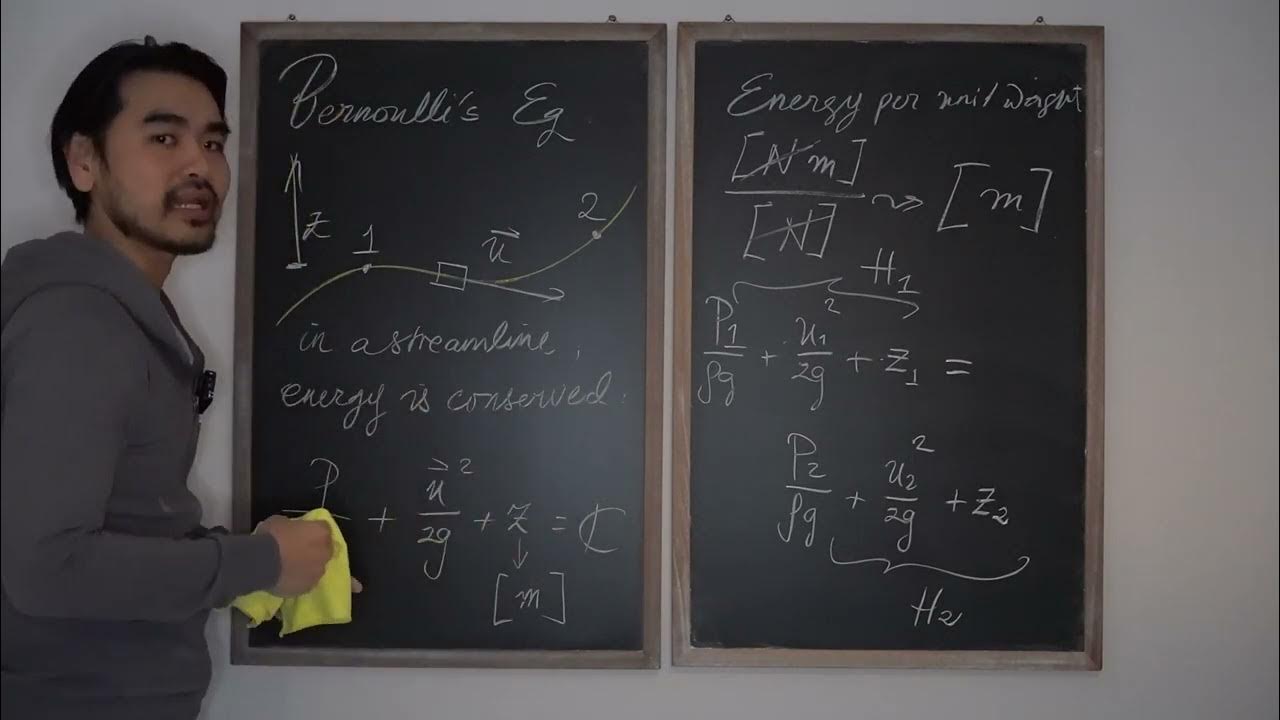👉 Importancia | Ecuación General de la Energía en Fluidos
Summary
TLDRIn this lecture, the professor introduces the energy equation in fluid mechanics through practical applications. The first example focuses on hydroelectric power plants, where water flows through turbines to generate electricity, highlighting the conversion of kinetic energy into electrical power. The second example covers irrigation pumping systems, where energy is added to the fluid to move it through pipes, demonstrating the role of pumps, valves, and filters. The professor uses these applications to motivate students before transitioning to the theoretical concepts and exercises, providing a balanced approach to learning fluid mechanics.
Takeaways
- 😀 The focus of the video is on the equation of energy and fluid mechanics.
- 😀 The equation of energy is an evolution of Bernoulli's equation.
- 😀 The first application discussed is the hydroelectric power plants, where water is used to rotate turbines to generate electricity.
- 😀 The turbines in hydroelectric plants are designed for liquids, unlike those in thermal plants, which are designed for steam.
- 😀 In hydroelectric systems, a generator converts rotational energy from the turbines into electrical energy.
- 😀 The flow of water continues through the river after the energy conversion process in hydroelectric plants.
- 😀 The second application covered is drip irrigation systems, where energy is added to the fluid to facilitate its movement through pipes to agricultural areas.
- 😀 In drip irrigation systems, energy is supplied by pumps to move the fluid through pipes and accessories like valves, filters, and joints.
- 😀 The difference between the two applications is that, in the case of irrigation, energy is added to the fluid, whereas in hydroelectric plants, the energy comes from the water's movement.
- 😀 The video introduces fundamental concepts related to energy equations, specifically targeting fluid mechanics, with practical applications in agriculture and energy generation.
- 😀 The script emphasizes that understanding the mechanics of fluid systems is crucial for professionals in industries like agriculture and energy generation.
Q & A
What is the general focus of this video?
-The video focuses on explaining the energy equation and its application in fluid mechanics, particularly through real-world examples such as hydroelectric power plants and irrigation systems.
What is the relationship between the energy equation and Bernoulli’s equation?
-The energy equation is an evolution of Bernoulli’s equation. While Bernoulli’s equation focuses on the conservation of energy in a flowing fluid, the energy equation expands on this by including additional factors such as work done by pumps or turbines.
What is one application of the energy equation mentioned in the video?
-One application discussed is hydroelectric power generation, where water flows through turbines, generating rotational movement that is converted into electrical energy.
How does a hydroelectric power plant work, according to the video?
-In a hydroelectric power plant, water flows from a higher elevation through a pipeline to a lower level, passing through turbines. The turbines spin, generating rotational movement, which drives a generator to produce electricity.
What role do turbines play in hydroelectric power plants?
-Turbines in hydroelectric power plants convert the kinetic energy of the flowing water into rotational energy. This rotational energy is then used to drive a generator, which produces electricity.
What is the difference between turbines used in hydroelectric plants and those used in thermal power plants?
-The turbines in hydroelectric plants are designed for liquids (water), while turbines in thermal power plants are designed for steam. The key difference lies in the medium that drives the turbine—water versus steam.
What is the second application of the energy equation mentioned?
-The second application involves pumping systems, such as drip irrigation systems, where energy is added to the fluid (water) to move it through pipes to the required destination, as opposed to a system where energy is lost.
What is the function of a pump in a drip irrigation system?
-The pump in a drip irrigation system adds energy to the water, allowing it to travel through the pipes and reach the desired locations, such as crops, even if the water must travel uphill or over long distances.
What are some components of a pumping system mentioned in the video?
-The components of a pumping system mentioned include pipes, accessories like valves and manometers, and pumps themselves, which help move water in systems like irrigation or industrial applications.
How does the energy lost in a pumping system affect its design?
-Energy loss in a pumping system occurs as the fluid travels through the pipes, losing pressure and energy. To compensate for this, the pump must be selected to ensure it can supply enough energy to overcome these losses and deliver the fluid to its destination.
Outlines

This section is available to paid users only. Please upgrade to access this part.
Upgrade NowMindmap

This section is available to paid users only. Please upgrade to access this part.
Upgrade NowKeywords

This section is available to paid users only. Please upgrade to access this part.
Upgrade NowHighlights

This section is available to paid users only. Please upgrade to access this part.
Upgrade NowTranscripts

This section is available to paid users only. Please upgrade to access this part.
Upgrade NowBrowse More Related Video

Mekanika Fluida FM01 (Lecture3: 1/8). Persamaan Bernoulli (Pengenalan)

MekFlu #2: Persamaan Bernoulli, Kontinuitas dan Kekekalan Energi

Dinamika Fluida

General Introduction to Fluid Mechanics and its Engineering Applications

Mekanika Fluida FM01 (Lecture3: 8/8). Energy Line & Hydraulic Grade Line

#MECFLU 20 Equação da Quantidade de Movimento P01 - Mecânica dos Fluidos
5.0 / 5 (0 votes)